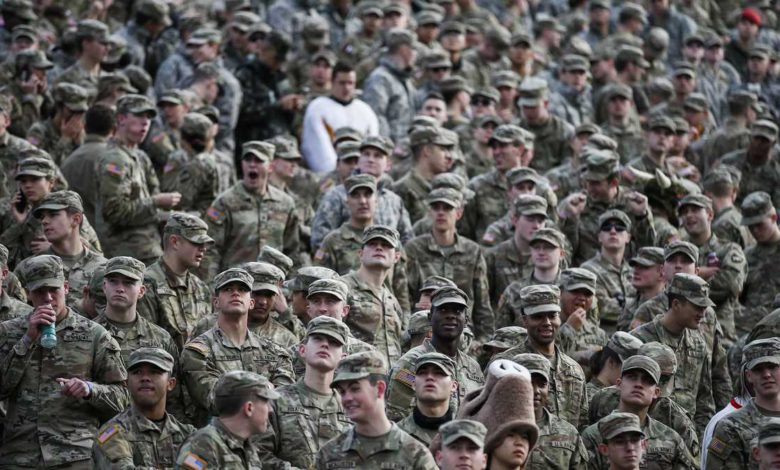

Eight years after he graduated from the U.S. Military Academy at West Point, Geoffrey Easterling remains astonished by the Confederate history still memorialized on the storied academy's campus – the six-foot-tall painting of Confederate Gen. Robert E. Lee in the library, the barracks dormitory named for Lee and the Lee Gate on Lee Road.As a Black student at the Army academy, he remembers feeling "devastated" when a classmate pointed out the slave also depicted in the Lee painting. "How did the only Black person who got on a wall in this entire humongous school — how is it a slave?" he recalls thinking.As a diversity admissions officer, he later traveled the country recruiting students to West Point from underrepresented communities. "It was so hard to tell people like, 'Yeah, you can trust the military,' and then their kids Google and go 'Why is there a barracks named after Lee?'" he said.The nation's military academies provide a key pipeline into the leadership of the armed services and, for the better part of the last decade, they have welcomed more racially diverse students each year. But beyond blanket anti-discrimination policies, these federally funded institutions volunteer little about how they screen for extremist or hateful behavior, or address the racial slights that some graduates of color say they faced daily.In an Associated Press story earlier this year, current and former enlistees and officers in nearly every branch of the armed services described a deep-rooted culture of racism and discrimination that stubbornly festers, despite repeated efforts to eradicate it. Less attention has been paid to the premiere institutions that produce a significant portion of the services' officer corps – the academies of the U.S. Army, the U.S. Navy, the U.S. Air Force, the U.S. Coast Guard and U.S. Merchant Marine.Some graduates of color from the nation's top military schools who endured what they describe as a hostile environment are left questioning the military maxim that all service members wearing the same uniform are equal.That includes Carlton Shelley II, who was recruited to play football for West Point from his Sarasota, Florida, high school and entered the academy in 2009. On the field, he described the team as "a brotherhood," where his skin color didn't matter. But off the field, he said, he and other Black classmates too often were treated like the stereotype of the angry Black man.Some students of color have spotlighted what they see as systemic discrimination at the academies by creating Instagram accounts — "Black at West Point," "Black at USAFA" and "Black at USNA" — to relate their personal experiences.In response to the AP's findings, a spokesman for the Department of Defense, Maj. Charlie Dietz, said the academies make it a policy to offer equal opportunities regardless of race, color, national origin, religion, sex, gender identity or sexual orientation. He said the DOD formed a team in April to advance progress on diversity, equity and inclusion across the entire department, including the academies.The latest annual defense spending bill mandated that the Defense Department survey all its military properties for references or symbols that potentially commemorate the Confederacy, including at West Point, which the commission overseeing the work picked as its first site to visit earlier this year. But the deadline to act on any recommendations is still more than two years away.Following the murder of George Floyd in 2020, which sparked global protests, a group of West Point alums released a 40-page letter urging the academy to address "major failures" in combatting intolerance and racism, adding "we hold fast to the hope that our Alma Mater will take the necessary steps to champion the values it espouses."Shelley said the academy has significant work to do to retain and support students of color. In his class, he estimated about 35 Black students graduated — "some crazy low number," he said. "And we started with a lot more."West Point did not respond to repeated requests for comment, beyond reiterating the importance of diversity to its admissions process.The academies are a growing pathway to officer status for Black cadets, 2019 data from the Under Secretary of Defense shows, with about 13% of Black active-duty officers commissioned through the five institutions, compared to 19% of white active-duty officers.Most students who enroll — about 60-70% — are nominated by U.S. senators or representatives from their home states as part of a system created in the 1840s to build a geographically diverse officer corps. But today, the country's changed demographics mean the system gives disproportionate influence to rural congressional districts that tend to be whiter.Only 6% of nominations to the Army, Air Force and Naval academies made by the current members of Congress went to Black candidates, even though 15% of the population aged 18 to 24 is Black, according to a March report by the Connecticut Veterans' Legal Center. Eight percent of congressional nominations went to Hispanic students, though they make up 22% of young adults, the report said.The diversity of nominations has improved slightly in the past 25 years, but the report noted that 49 Congress members did not nominate a single Black student while in office and 31 nominated no Hispanic candidates.Curtis Harris said he was awarded one of just three nominations to West Point out of more than 300 applications to his congressman. Now, he helps review applications for a New York Congressman and visits schools to encourage young candidates of diverse backgrounds to apply.Diversifying West Point is "not going to happen by itself," he said. According to data supplied to the AP by the four schools, the Naval, Air Force, Merchant Marine and Coast Guard academies have generally become less white over the past two decades. West Point did not provide full data, but said it is increasingly welcoming diverse students, with 37% of the class of 2024 identifying as nonwhite, compared to about 25% a decade ago.While the number of Hispanic cadets increased in the past two decades at the Coast Guard and Naval academies, Black cadets showed no noticeable increase during that time. In the class of 2000, there were 73 Black midshipmen in the Naval Academy and just 77 in 2020. At the Coast Guard Academy, there were 15 Black cadets in the 2001 class. And in 2021? Merely 16.Two of the five academies -- West Point and the Air Force Academy -- now have their first Black leaders. But Easterling, the West Point graduate, noted that the faculty there remains mostly white, meaning students who "don't see themselves, and don't want to stay" can find it hard to ask for help. Greg Elliott said he often found himself in trouble while at the Merchant Marine Academy and was asked to leave without graduating. He said he didn't face overt racism, but wonders if a more diverse faculty and student body could have changed his course by making him feel he belonged.He recalls a fellow Black alum telling him to just plow through with his head down and realize the academy was "a terrible place to be at, but it's a great place to be from."___AP writers James LaPorta in Miami and Kat Stafford in Detroit and data intern Jasen Lo in Chicago contributed to this story.Wieffering is a Roy W. Howard Investigative Fellow.
Eight years after he graduated from the U.S. Military Academy at West Point, Geoffrey Easterling remains astonished by the Confederate history still memorialized on the storied academy's campus – the six-foot-tall painting of Confederate Gen. Robert E. Lee in the library, the barracks dormitory named for Lee and the Lee Gate on Lee Road.
As a Black student at the Army academy, he remembers feeling "devastated" when a classmate pointed out the slave also depicted in the Lee painting. "How did the only Black person who got on a wall in this entire humongous school — how is it a slave?" he recalls thinking.
As a diversity admissions officer, he later traveled the country recruiting students to West Point from underrepresented communities. "It was so hard to tell people like, 'Yeah, you can trust the military,' and then their kids Google and go 'Why is there a barracks named after Lee?'" he said.
The nation's military academies provide a key pipeline into the leadership of the armed services and, for the better part of the last decade, they have welcomed more racially diverse students each year. But beyond blanket anti-discrimination policies, these federally funded institutions volunteer little about how they screen for extremist or hateful behavior, or address the racial slights that some graduates of color say they faced daily.
In an Associated Press story earlier this year, current and former enlistees and officers in nearly every branch of the armed services described a deep-rooted culture of racism and discrimination that stubbornly festers, despite repeated efforts to eradicate it. Less attention has been paid to the premiere institutions that produce a significant portion of the services' officer corps – the academies of the U.S. Army, the U.S. Navy, the U.S. Air Force, the U.S. Coast Guard and U.S. Merchant Marine.
Some graduates of color from the nation's top military schools who endured what they describe as a hostile environment are left questioning the military maxim that all service members wearing the same uniform are equal.
That includes Carlton Shelley II, who was recruited to play football for West Point from his Sarasota, Florida, high school and entered the academy in 2009. On the field, he described the team as "a brotherhood," where his skin color didn't matter. But off the field, he said, he and other Black classmates too often were treated like the stereotype of the angry Black man.
Some students of color have spotlighted what they see as systemic discrimination at the academies by creating Instagram accounts — "Black at West Point," "Black at USAFA" and "Black at USNA" — to relate their personal experiences.
In response to the AP's findings, a spokesman for the Department of Defense, Maj. Charlie Dietz, said the academies make it a policy to offer equal opportunities regardless of race, color, national origin, religion, sex, gender identity or sexual orientation. He said the DOD formed a team in April to advance progress on diversity, equity and inclusion across the entire department, including the academies.
The latest annual defense spending bill mandated that the Defense Department survey all its military properties for references or symbols that potentially commemorate the Confederacy, including at West Point, which the commission overseeing the work picked as its first site to visit earlier this year. But the deadline to act on any recommendations is still more than two years away.
Following the murder of George Floyd in 2020, which sparked global protests, a group of West Point alums released a 40-page letter urging the academy to address "major failures" in combatting intolerance and racism, adding "we hold fast to the hope that our Alma Mater will take the necessary steps to champion the values it espouses."
Shelley said the academy has significant work to do to retain and support students of color. In his class, he estimated about 35 Black students graduated — "some crazy low number," he said. "And we started with a lot more."
West Point did not respond to repeated requests for comment, beyond reiterating the importance of diversity to its admissions process.
The academies are a growing pathway to officer status for Black cadets, 2019 data from the Under Secretary of Defense shows, with about 13% of Black active-duty officers commissioned through the five institutions, compared to 19% of white active-duty officers.
Most students who enroll — about 60-70% — are nominated by U.S. senators or representatives from their home states as part of a system created in the 1840s to build a geographically diverse officer corps. But today, the country's changed demographics mean the system gives disproportionate influence to rural congressional districts that tend to be whiter.
Only 6% of nominations to the Army, Air Force and Naval academies made by the current members of Congress went to Black candidates, even though 15% of the population aged 18 to 24 is Black, according to a March report by the Connecticut Veterans' Legal Center. Eight percent of congressional nominations went to Hispanic students, though they make up 22% of young adults, the report said.
The diversity of nominations has improved slightly in the past 25 years, but the report noted that 49 Congress members did not nominate a single Black student while in office and 31 nominated no Hispanic candidates.
Curtis Harris said he was awarded one of just three nominations to West Point out of more than 300 applications to his congressman. Now, he helps review applications for a New York Congressman and visits schools to encourage young candidates of diverse backgrounds to apply.
Diversifying West Point is "not going to happen by itself," he said.
According to data supplied to the AP by the four schools, the Naval, Air Force, Merchant Marine and Coast Guard academies have generally become less white over the past two decades. West Point did not provide full data, but said it is increasingly welcoming diverse students, with 37% of the class of 2024 identifying as nonwhite, compared to about 25% a decade ago.
While the number of Hispanic cadets increased in the past two decades at the Coast Guard and Naval academies, Black cadets showed no noticeable increase during that time. In the class of 2000, there were 73 Black midshipmen in the Naval Academy and just 77 in 2020. At the Coast Guard Academy, there were 15 Black cadets in the 2001 class. And in 2021? Merely 16.
Two of the five academies -- West Point and the Air Force Academy -- now have their first Black leaders. But Easterling, the West Point graduate, noted that the faculty there remains mostly white, meaning students who "don't see themselves, and don't want to stay" can find it hard to ask for help.
Greg Elliott said he often found himself in trouble while at the Merchant Marine Academy and was asked to leave without graduating. He said he didn't face overt racism, but wonders if a more diverse faculty and student body could have changed his course by making him feel he belonged.
He recalls a fellow Black alum telling him to just plow through with his head down and realize the academy was "a terrible place to be at, but it's a great place to be from."
___
AP writers James LaPorta in Miami and Kat Stafford in Detroit and data intern Jasen Lo in Chicago contributed to this story.
Wieffering is a Roy W. Howard Investigative Fellow.
Source link







